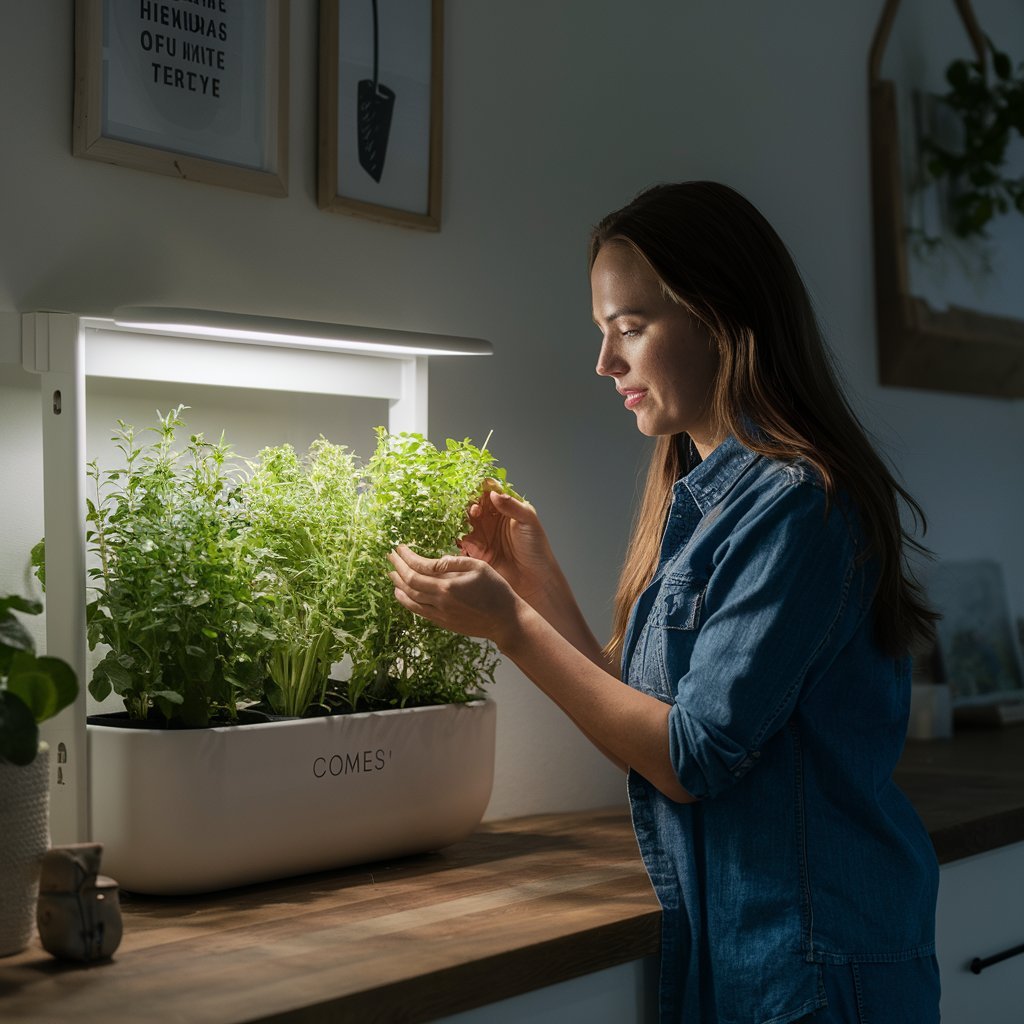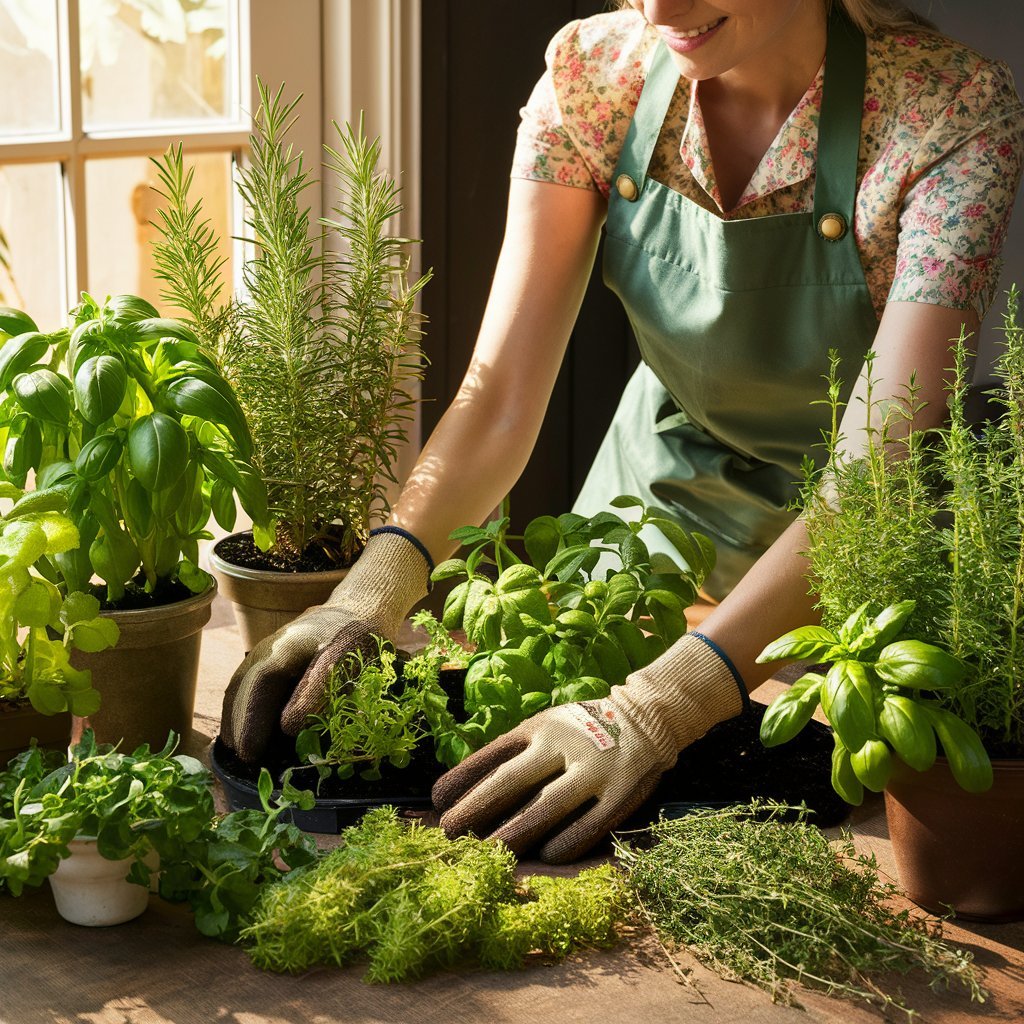Why Growing Herbs Indoors Rocks
Growing herbs indoors has become one of my favorite pastimes. It’s not just about having fresh ingredients at my fingertips; it’s also a fantastic way to boost mental wellness. Let’s chat about why this is such a rewarding hobby.
Mental Wellness Perks
For me, taking care of plants is like a mini-vacation from the daily grind. Tending to my indoor herb garden gives me a break from the chaos, letting me focus on the simple joy of nurturing life. Studies even back this up, showing that gardening can zap stress and lift your mood. It’s a win-win for anyone looking to feel better.
Here’s a quick rundown of the mental wellness perks:
- Stress Buster: Hanging out with my plants helps me chill out and de-stress.
- Achievement Unlocked: Watching my herbs sprout and grow gives me a real sense of accomplishment.
- Mindfulness Boost: The routine of watering and checking on my plants keeps me grounded and present.
Fresh Herbs Anytime
One of the best things about growing herbs indoors is having fresh herbs on hand all year round. Whether it’s freezing outside or scorching hot, I can still enjoy the fresh flavors of basil, mint, rosemary, and more. This is especially handy during the off-season, letting me savor fresh herbs like thyme or basil anytime (Laidback Gardener).
Here are some of my go-to indoor herbs:
| Herb | Culinary Uses |
|---|---|
| Basil | Pesto, salads, pasta |
| Mint | Teas, desserts, cocktails |
| Rosemary | Roasts, soups, bread |
| Chives | Garnishes, omelets, dips |
| Parsley | Soups, stews, garnishes |
| Oregano | Pizza, marinades, sauces |
| Sage | Stuffing, sausages, butter |
| Thyme | Meat dishes, stews, soups |
| Lemongrass | Thai dishes, teas, curries |
| Chervil | Soups, salads, sauces |
| Cilantro | Salsas, guacamole, curries |
| Bay | Stews, soups, sauces |
| Dill | Pickling, salads, fish dishes |
| Tarragon | Chicken dishes, salad dressings, sauces |
| Chamomile | Teas, skincare |
Having these herbs at my fingertips means I can jazz up my cooking with fresh flavors anytime. Plus, it saves me trips to the store and ensures I always have top-notch, pesticide-free herbs on hand.
For more tips on how to grow herbs indoors and setting up your indoor herb garden, check out the other sections of this guide. Curious about the best containers for herbs? Don’t miss our article on container gardening for herbs.
Essential Tips for Indoor Herb Gardening
Growing herbs indoors has been a game-changer for me. Let me share some tips on watering and drainage to help you create your own indoor herb haven.

Watering Techniques
Watering is key when it comes to indoor herbs. Unlike outdoor plants, container herbs dry out faster and need more frequent watering. Here’s what works for me:
- Check Soil Dryness: Stick your finger about an inch into the soil. If it feels dry, it’s time to water.
- Water Thoroughly: Water until you see it draining from the bottom. This ensures the roots get enough moisture.
- Bottom Watering: Place the pot in a shallow tray of water and let the soil soak up the moisture from below.
Here’s a quick guide on how often to water some common indoor herbs:
| Herb | Watering Frequency |
|---|---|
| Basil | Every 2-3 days |
| Mint | Every 3-4 days |
| Rosemary | Every 7-10 days |
| Thyme | Every 7-10 days |
Overwatering can cause root rot, fungus gnats, and yellow leaves. So, balance is crucial.
Importance of Drainage
Good drainage is just as important. Without it, water can pool at the bottom, leading to root rot. Here’s how I ensure proper drainage:
- Use Containers with Drainage Holes: Always pick pots with holes at the bottom to let excess water escape.
- Soil Mix: Use a loose, well-draining soil mix. I prefer a blend of potting soil and perlite.
- Layering: Add a layer of small stones or broken pottery at the bottom of the pot before adding soil. This helps with drainage.
For anyone starting out, container gardening for herbs is a great place to begin.
By following these watering and drainage tips, my indoor herb garden has thrived. If you want more tips on how to grow herbs indoors, check out our other resources. Happy gardening!
Setting Up Your Indoor Herb Garden
Starting an indoor herb garden is like bringing a bit of nature’s magic into your home. Fresh flavors, a touch of green, and a boost to your mood—what’s not to love? Here’s how I got mine going, with a focus on lighting and picking the right herbs.
Getting the Lighting Right
Light is the secret sauce for growing herbs indoors. Most herbs crave at least six hours of sunlight daily. If you’ve got a south-facing window, you’re golden. West-facing works too. Just remember to rotate your pots so every leaf gets its share of the sun (Piedmont Master Gardeners).
No sunny windows? No problem. LED grow lights are your new best friend. They give off the perfect light that herbs love (Laidback Gardener). I keep my herbs about 6-12 inches from two 40-watt, cool white fluorescent bulbs for 14-16 hours a day. This way, they soak up all the light they need without getting scorched.
Here’s a quick cheat sheet for lighting needs:

| Herb | Light Requirement | Ideal Light Source |
|---|---|---|
| Basil | 12-16 hours | LED grow light |
| Mint | 6-8 hours | Southern exposure |
| Rosemary | 12-16 hours | Fluorescent bulbs |
| Parsley | 6-8 hours | Western exposure |
Picking the Right Herbs
Not all herbs are created equal when it comes to indoor gardening. Some are divas, while others are more laid-back. Here are a few that have turned my indoor garden into a green paradise:
- Basil: Loves light and regular watering. Perfect for pesto and pasta.
- Mint: Easy-going and does well with moderate light. Great for teas and mojitos.
- Rosemary: Needs lots of light but not much water. Its fragrant leaves are a must-have.
- Parsley: Happy with partial sunlight. Ideal for garnishing and adding a fresh touch to dishes.
For a full rundown of herbs that thrive indoors, check out our article on the best herbs to grow indoors.
By nailing the lighting and picking the right herbs, you can create an indoor herb garden that’s not just a feast for the eyes but also for your taste buds. Want more tips on container gardening? Head over to our guide on container gardening for herbs.
- A LUSH OASIS IN YOUR HOME: Elevate your indoor space with a vibrant array of nine gourmet herbs. Feel the unparalleled f…
- THE ULTIMATE KIT: You get everything you need to start and sustain your herb garden. From seeds to full bloom, our kit e…
- NO GREEN THUMB REQUIRED: Whether you’re a seasoned gardener or just starting, our step-by-step guide simplifies the proc…

- The Perfect Gift for Women Who Love Freshness and Creativity: Surprise her with a thoughtful, practical gift that keeps …
- Complete, Gift-Ready Kit with Everything She Needs: This beautifully packaged set includes 8 herb seed packets, 2 differ…
- A Special Touch of Green for Any Space: The compact, stylish design fits perfectly in kitchens, balconies, or living are…

- Indoor Herb Garden Planter with Tray – Add greenery to your home with this vintage metal windowsill planter. Herb plante…
- Decorative Window Planter – Keep your fresh herb plants and spices like basil and rosemary close at hand! Or, fill the d…
- Drain Holes and Tray – These rustic herb pots for indoor plants and outdoor come with drainage holes and a snug fitting …

- This Hydroponics Growing System Kit is an ideal choice to get it for yourself or a perfect Christmas gifts for women mom…
- 20% Faster than Soil Planting: The integrated low noise pump of hydroponics growing system kit aerates the water to stim…
- 4.5L Water Tank and Fan: Hydroponics growing system kit built-in a fan which spreads pollen in florescence, disperses he…
Keeping Your Indoor Herb Garden Happy
You’ve got your indoor herb garden set up, now let’s keep those plants happy and healthy. Here’s the lowdown on soil, feeding, and dealing with those pesky pests and diseases.
Soil and Feeding
Herbs aren’t too fussy, but they do like their soil just right. Most herbs dig a loose, well-draining mix. A soilless potting mix works wonders for many indoor herbs. To keep things airy and prevent soggy roots, mix in some perlite. You can whip up your own blend with potting soil, organic matter, and perlite for top-notch drainage and aeration.
| Soil Component | Why It’s Great |
|---|---|
| Potting Soil | The main stuff |
| Organic Matter | Adds nutrients |
| Perlite | Keeps things airy and drains well |
Feeding your herbs is like giving them a little pep talk. A balanced fertilizer once a month should do the trick. But don’t go overboard—too much can be a bad thing. Stick to the instructions on the package to avoid any mishaps.
Battling Pests and Diseases
Even indoor gardens can get unwanted visitors. Here’s how to handle some common issues:
Root Rot: This nasty problem happens when roots sit in water too long, leading to wilting and mushy roots. Make sure your pots have drainage holes and don’t overwater. Check the soil before you water to keep things just right.
Aphids: These tiny bugs love to munch on your plants, causing twisted growth and leaving behind a sticky mess. Keep an eye on your plants and if you spot these critters, a bit of insecticidal soap or neem oil should send them packing.
| Problem | Symptoms | Fix It |
|---|---|---|
| Root Rot | Wilting, mushy roots | Good drainage, careful watering |
| Aphids | Twisted growth, sticky leaves | Insecticidal soap, neem oil |
Stick to these tips, and your indoor herb garden will be the envy of all your friends. For more tips and tricks on growing herbs indoors, check out our guides on how to grow herbs indoors and the best herbs to grow indoors.

My name is Michelle Warren, and I’m the founder of Peaceful Gardening. As a 10-year breast cancer survivor, I’ve discovered the profound therapeutic power of gardening. This journey has not only helped me recover but has also become my passion and a source of ongoing peace and joy.
Peaceful Gardening was born from my desire to share the healing benefits of gardening with others. Whether you’re facing health challenges, dealing with stress, or simply looking to connect more deeply with nature, this space is for you.
Over the past decade, I’ve cultivated not just plants, but a deep understanding of how gardening can positively impact mental health. I’ve worked with local community gardens, led workshops on mindful gardening practices, and collaborated with mental health professionals to develop gardening-based stress reduction programs.
Peaceful Gardening was born from my desire to share the healing benefits of gardening with others. Whether you’re facing health challenges, dealing with stress, or simply looking to connect more deeply with nature, this space is for you.
Here, you’ll find evidence-based advice on using gardening as a tool for mindfulness, stress relief, and emotional healing. I share personal stories, practical tips, and scientifically-backed information on how to create your own therapeutic garden space, no matter the size of your yard or balcony.
My mission is to help you discover the joy, peace, and healing that comes from nurturing plants and connecting with nature. Join me in exploring how the simple act of tending to a garden can transform your mental and emotional wellbeing.
Welcome to Peaceful Gardening – let’s grow together towards better mental health!”





